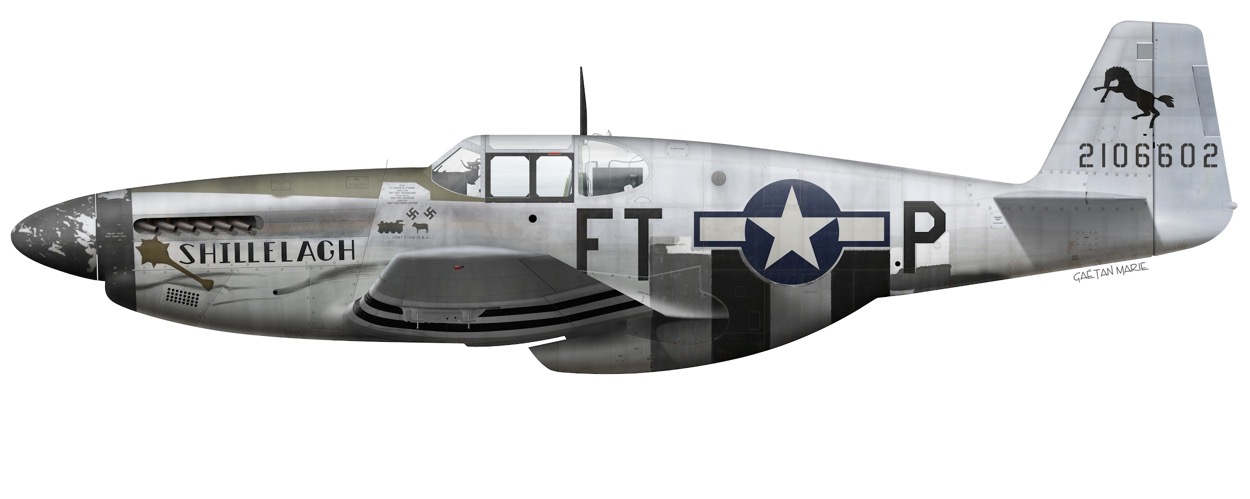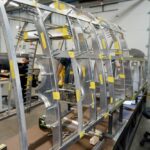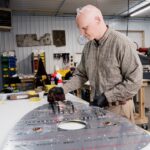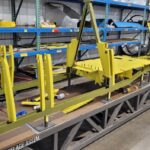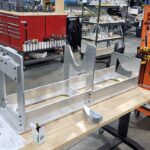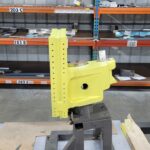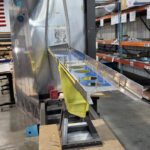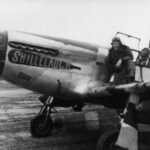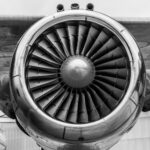Wings of the North Air Museum’s P-51B Mustang Restoration – Update 4: Winter 2022
As most readers will be well aware, AirCorps Aviation has completed numerous world-class aircraft restorations over the past decade or so at their now-famed workshop in Bemidji, Minnesota. Not an organization to rest on its laurels, AirCorps is working hard on a number of fascinating projects at present, one of which they started in mid-2021 for the Wings of the North Air Museum in Eden Prairie, Minnesota. This particular effort is based around the mortal remains of a rare, early-model Mustang with an extensive combat history, this being P-51B 42-106602 nicknamed Shillelagh. Two of those who flew the Mustang also have interesting histories: David O’Hara, Shillelagh’s regular pilot (who named her) and Kenneth H. Dahlberg, the triple-ace and former Prisoner Of War who was at the controls on the fighter’s final mission. As already noted, Shillelagh’s rebuild began in earnest at AirCorps Aviation during 2021, and much has taken place in the interim. So without further ado, here is Chuck Cravens’ fourth report on Shillelagh…
Update
Work this month included completion of the primary fuselage framework, and trial fitting the first components in the wing assembly fixture. The team also finished the tailcone assembly. They also took apart the clecoed-together fuselage framework to paint the individual components, and then began its permanent reassembly with rivets.
Fuselage
This month the team fitted and clecoed together the forward fuselage framework. They then took it all apart for painting. Once the paint was dry, the team began reassembling the structure with rivets.
Engine Mount
The engine mount which Shillelagh will use is a NOS (New Old Stock) example obtained from the noted and now-retired warbird parts dealer, Jay Wisler. It had once been a part of the late Connie Edwards’ collection and is in near-perfect condition. Shillelagh will contain many components of original wartime manufacture.
shipping supports from the North American factory. (image via AirCorps Aviation)
parts with holes for the mounting bolts through them. (image via AirCorps Aviation)
A QEC (Quick Engine Change) unit typically consists of the engine in its mount along with associated components and accessories. Keeping all of these items together as a single assembly allowed squadron or depot-level maintenance personnel to perform a relatively rapid engine change. By simply disconnecting the relevant linkages, hoses, and tubing along with the four large bolts which attach the engine mount to the firewall, an entire QEC unit could be dismounted and exchanged with a new one. The aircraft could then return quickly to the front lines, while the often time-consuming task of troubleshooting or even overhauling an engine fault could take place offline, so to speak.
Tailcone
The team effectively completed their work on the tailcone this month.
Wings
Work on fabricating the spars helped start the process of building up Shillelagh’s wings. The team prepared the assembly fixture and mounted the first wing components to it.
The Pioneer Mustang Group
The 354th Fighter Group (FG) was the first US Army Air Forces unit to fly Rolls-Royce Merlin powered P-51B Mustangs in combat, which gained them the unofficial sobriquet as the Pioneer Mustang Group. Perhaps not coincidentally, the 354th FG also had greater success in combat than any other U.S. Fighter Group in the European theater, with an official tally of 701 enemy aircraft shot down in air-to-air engagements.
The 354th FG was assigned to the 9th Fighter Command under the command of Brigadier General Elwood R. “Pete” Quesada. The 9th Air Force began initially as V Air Support Command, constituted on August 21st, 1941 and then activated a week later on September 1st. Redesignation to the 9th AF took place in April of the following year. The 9th moved to Egypt and began operations on November 12th, 1942, participating in the Allied drive across Egypt and Libya, the campaign in Tunisia, and the invasions of Sicily and Italy. The 9th AF then moved to England in October, 1943, where it became the tactical air force for the invasion of Continental Europe. From 1943 onwards, the 9th AF helped prepare for the assault on Normandy. It then supported operations on the beachheads in June 1944, and took part in the Allied drive across France, the low countries and into Germany, culminating in victory during May, 19451.
The first P-51Bs to reach England were assigned to the 354th Fighter Group under the 9th Air Force. The 9th’s primary mission in Europe was tactical support for ground troops. However, when General H.H. “Hap” Arnold learned about the Merlin-powered Mustang’s capabilities, he decided that the new P-51B could solve the 8th Air Force’s urgent need for a long-range bomber escort.
To facilitate this escort role for the improved fighter, (instead of the tactical role which the 9th AF typically fulfilled), General Ira Eaker arranged for the 354th FG to become operationally assigned to the 8th Air Force, while remaining administratively a part of the 9th Air Force.
The 354th’s P-51Bs first entered combat on December 1st, 1943, “regularly accompanying Eighth Air Force Heavy bombers over their targets deep in Germany. The new Mustangs proved magnificently successful in aerial combat, constantly meeting and defeating superior forces of German aircraft which threatened the heavy bomber formations.”2
1Army Air Corps Library and Museum, https://www.armyaircorpsmuseum.org/wwii_9th_Air_Force.cfm, accessed 12-22-2022
2Richard H. Kohn and Joseph P Harahan, USAF Warrior Studies, Condensed Analysis of the Ninth Air Force in the European Theater of Operations, New Imprint, Office of Air Force History, United States Air Force, Washington D.C., 1984, page 16
Shillelagh arrived in England during early April, 1944 and flew its first combat mission with the 354th FG on April 15th.
The 354th Fighter Group was comprised of the 353rd, 355th, and 356th Fighter Squadrons. David O’Hara’s Shillelagh and Ken Dahlberg were flew with the 353rd FS. By late May 1944, the 354th FG had fewer escort missions to perform, taking on tactical roles more regularly as the Allies prepared to invade “Fortress Europe”.
“The Group escorted gliders on D-Day on 6 June 1944 and in the course of that month continued to strike targets like railways lines and German gun positions in support of Allied troop positions in northern France. The Group was awarded two Distinguished Unit Citations, the first for their work escorting bombers in the first half of 1944 and the second for a series of successful fighter sweeps that destroyed numerous enemy aircraft in the air and on the ground on 25 August 1944. The Group supported the Battle of the Bulge that winter and Allied troops fighting at the Rhine river in early 1945.”3
In November 1944, the 354th FG received some rather unwelcome orders which involved having to replace their beloved P-51Bs with P-47Ds. The Thunderbolt’s arrival signaled an end to the Group’s armed reconnaissance missions, where pilots went looking for trouble in the air; they now engaged in dive-bombing, strafing, and troop support, more in keeping with the 9th Tactical Air Forces’ typical remit.4
3American Air Museum in Britain Accessed 12-27-2022
4William Ness, 354th Fighter Group,Osprey Publishing; Illustrated edition (March 25, 2002) p98
The 354th flirted only briefly with the Thunderbolt, however, regaining their Mustangs by the middle of February, 1945. Oddly enough, Ken Dahlberg missed the changeover because he had already become a POW. His aircraft (P-47D-25 Thunderbolt 42-29336 – FT-O) suffered significant damage from 88mm flak during a ground attack mission on February 14th, 1945; Dahlberg survived the resulting shoot down, his third, but could not evade capture this time spending three months in a German Prisoner of War Camp.
Interestingly, Ken Dahlberg’s first experience being shot down took place on a mission while he was flying Shillelagh in August 1944. Bailing out of the stricken Mustang, he was fortunate to land on the property of Baron Denis Baudoin. Had he a choice, Dahlberg could not have picked a better spot to land, because Denis and Madeleine Baudoin were members of the French Resistance and played an instrumental role in his successful escape back to his unit – we will return to this fascinating story with greater detail in future restoration updates.
Ken Dahlberg’s second experience getting shot down took place on Boxing Day, 1944 – during the Battle of the Bulge. Dahlberg was flying P-47D FT-K that day when his aircraft took damage from enemy ground fire during an armed reconnaissance mission in the Bastogne region. He performed a successful belly-landing, but found himself three miles behind enemy lines. Thankfully, an American tank crew bravely crossed into enemy territory to rescue the downed flier.
While Dahlberg’s WWII combat career ended on February 14th, 1945, the 354th Fighter Group’s war continued. On February 16th, 1945, just two days after Ken Dahlberg’s capture, the 354th flew its first mission in their new P-51D Mustangs.
With the return of their P-51s, the 354th FG once again became the Pioneer Mustang Group For the remainder of the war, their missions almost exclusively involved fighter sweeps and patrols in support of Allied troops as they crossed the Rhine and advanced into Germany.
The Pioneer Mustang Group recorded many notable “firsts” – as shown below:
- First to fly the longe range Mustang in combat: December 1, 1943
- First long-distance escort: December 13, 1943 (Kiel, Germany 950 miles)
- Lt. Charles Gumm achieves the first aerial victory for the group: December 6, 1943,
- First 1100 mile mission to the border of Spain: December 31, 1943,
- First Merlin Mustangs to strafe on a mission: February 8, 1943, Frankfort, Germany
- First fighter over Berlin: March 3, 1944,
- First P-51B dive bombing mission: March 26, 1944, Creil, France
- First in aerial victories: total of 701
And that is all for the fourth edition of Chuck Cravens’ coverage describing the restoration of Wings of the North Air Museum’s P-51B Mustang Shillelagh at AirCorps Aviation. We will publish the next installment as soon as it becomes available! Many thanks to Chuck Cravens and especially to AirCorps Aviation for their continued, long-standing support!









